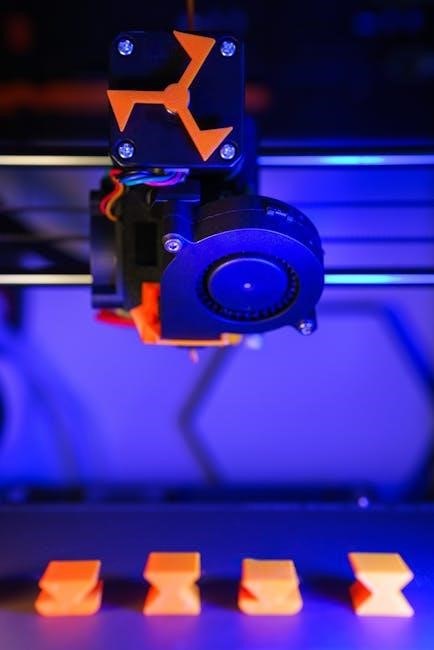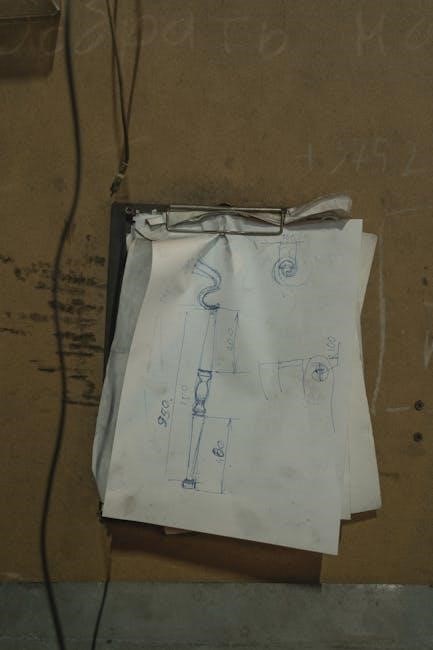The Engineering Design Process (EDP) is a structured approach to solving problems, emphasizing creativity and practicality. Worksheets, such as the engineering design process worksheet PDF, provide organized templates for each step, ensuring clarity and efficiency in project planning and execution.
1.1 What is the Engineering Design Process (EDP)?
The Engineering Design Process (EDP) is a structured, iterative approach used to solve complex problems. It involves identifying the problem, brainstorming solutions, and evaluating designs to create effective outcomes. The EDP emphasizes critical thinking, creativity, and practicality, guiding engineers through well-defined steps to achieve project goals. Worksheets, such as the engineering design process worksheet PDF, are essential tools for organizing and documenting each phase, ensuring clarity and efficiency in the design journey.
1.2 Why is the EDP Important in Engineering?
The Engineering Design Process (EDP) is crucial in engineering as it provides a systematic approach to solving problems, ensuring projects meet requirements and constraints. It fosters creativity, critical thinking, and collaboration, leading to innovative solutions. By breaking down complex tasks into manageable steps, the EDP improves efficiency and reduces errors. Worksheets, like the engineering design process worksheet PDF, guide engineers through each phase, promoting organization and clarity. This structured method ensures that designs are practical, effective, and aligned with project goals, making it indispensable in modern engineering practices.
Key Steps of the Engineering Design Process
The Engineering Design Process involves identifying problems, brainstorming solutions, selecting designs, planning, and creating models. Worksheets guide each phase, ensuring systematic and creative problem-solving in engineering projects.
2.1 Step 1: Identify the Problem
Identifying the problem is the foundation of the Engineering Design Process. Worksheets, such as the engineering design process worksheet PDF, provide dedicated sections for defining the challenge, ensuring clarity and focus. Engineers must articulate the goal and constraints, laying the groundwork for effective brainstorming and solution development. This step emphasizes understanding user needs and translating them into actionable objectives, ensuring the design aligns with practical requirements and stakeholder expectations.
2.2 Step 2: Identify Criteria and Constraints
After defining the problem, the next step is to identify criteria and constraints. Worksheets like the engineering design process worksheet PDF include sections for listing these elements, ensuring clarity. Criteria outline what the solution must achieve, while constraints limit possible solutions, such as budget, materials, or time. Clearly defining these factors helps narrow the design focus, ensuring the final solution is both practical and aligned with stakeholder expectations. This step is crucial for guiding the brainstorming process effectively.
2.3 Step 3: Brainstorm and Select the Best Design Idea
Brainstorming is a critical phase where creative ideas are generated to address the problem. Using an engineering design process worksheet PDF, teams can list potential solutions, encouraging wild and innovative thinking. After brainstorming, the next step is to evaluate and select the most feasible design idea. Worksheets often include sections for rating ideas based on criteria and constraints, helping teams reach a consensus. This step ensures that the chosen design aligns with the problem’s requirements and is practical to implement.
2.4 Step 4: Create a Plan and Gather Materials
Once a design idea is selected, the next step is to create a detailed plan and gather necessary materials. Worksheets, such as the engineering design process worksheet PDF, often include sections for outlining materials, tools, and budgets. This step ensures that the design can be realistically constructed. By breaking down the process into manageable tasks, teams can allocate resources effectively; A clear plan also helps identify potential challenges early, allowing for adjustments before implementation begins. This structured approach ensures the project stays on track and meets its objectives.
Worksheets in the Engineering Design Process
Worksheets are essential tools in the Engineering Design Process (EDP), providing structured templates to guide each step, from problem identification to solution implementation. They ensure organization, clarity, and accountability, making the design process more efficient and systematic. Using a engineering design process worksheet PDF helps teams stay focused and document their progress effectively, fostering collaboration and innovation throughout the project lifecycle.
3.1 What is an Engineering Design Process Worksheet?
An Engineering Design Process Worksheet is a structured document designed to guide users through each stage of the EDP. It provides organized sections for identifying problems, brainstorming ideas, selecting solutions, and planning implementation. These worksheets, often available as engineering design process worksheet PDF files, ensure that all aspects of a project are carefully considered and documented. They are invaluable for maintaining clarity and accountability, making them a cornerstone of effective engineering practices and education.
3.2 How to Use Worksheets for Each Step of the EDP
Using an engineering design process worksheet PDF, start by identifying the problem and its criteria. Each section guides you through brainstorming, selecting ideas, and planning. Fill out the worksheet step-by-step, documenting your progress. Use the PDF format for easy printing and accessibility. Ensure all sections are completed to maintain organization and accountability. This structured approach helps in systematically addressing each phase of the EDP, making it an essential tool for both educational and professional engineering projects.

Applications of the Engineering Design Process
The engineering design process worksheet PDF is widely used in STEM education and real-world engineering projects to guide problem-solving, enhance collaboration, and streamline project management effectively.
4.1 EDP in STEM Education
The Engineering Design Process (EDP) is integral to STEM education, fostering critical thinking and problem-solving skills. Worksheets like the engineering design process worksheet PDF provide structured templates for students to follow each step, from identifying problems to implementing solutions. These tools help students apply scientific and mathematical concepts to real-world challenges, making learning interactive and engaging. By using EDP worksheets, educators can guide students in developing innovative solutions while teaching collaboration and creativity. This approach prepares students for future careers in engineering and technology by simulating professional design practices.
4.2 EDP in Real-World Engineering Projects
In real-world engineering projects, the Engineering Design Process (EDP) is essential for developing efficient and innovative solutions. Professionals use engineering design process worksheet PDF templates to systematically guide projects from problem identification to implementation. These worksheets help define requirements, outline constraints, and organize brainstorming sessions. By following the EDP, engineers ensure their designs are practical, safe, and meet client needs. The structured approach also facilitates collaboration and iteration, making it a cornerstone of successful engineering practices across industries.

Tools and Resources for the EDP
Essential tools include engineering design process worksheet PDF templates, offering structured layouts for each step. These resources help engineers organize ideas, define constraints, and track progress efficiently.
5.1 Printable Worksheets for the EDP
Printable worksheets like the engineering design process worksheet PDF are invaluable for structuring projects. They include sections for problem identification, brainstorming, and design selection, ensuring a systematic approach. These resources are widely available online, with examples from platforms like Vivify STEM and TeachEngineering.org. Worksheets are designed to be user-friendly, offering clear prompts and space for detailed planning. They are ideal for educational settings, helping students and professionals alike to organize their thoughts and document progress effectively. Printable formats make them accessible for hands-on activities and teamwork.
5.2 Online Templates and Guides

Online templates and guides for the EDP are readily available, offering flexible tools for engineers and educators. Websites like Vivify STEM and TeachEngineering.org provide downloadable engineering design process worksheet PDFs and interactive guides. These resources often include editable fields, making them adaptable for various projects. Online platforms also offer step-by-step tutorials and examples, enhancing understanding and application. They are particularly useful for remote learning and collaborative projects, ensuring accessibility and consistency in the design process. These digital tools complement traditional worksheets, providing a modern approach to engineering problem-solving.

Examples of EDP Worksheets
Examples of EDP worksheets include activity-specific templates, such as the Super Slinger Engineering Challenge worksheet, which guides students through problem identification and solution design. These worksheets are often downloadable as engineering design process worksheet PDFs and include sections for brainstorming, planning, and evaluation, making them practical tools for both educational and professional settings.
6.1 Worksheets for Identifying Problems and Constraints
Worksheets for identifying problems and constraints are essential tools in the EDP. They provide structured sections for defining the problem, listing constraints, and outlining requirements. For example, the engineering design process worksheet PDF from TeachEngineering.org includes prompts to describe the problem in detail, identify stakeholders, and list constraints. These worksheets help ensure that all aspects of the problem are considered early in the design process, leading to more effective solutions. They are widely used in STEM education and real-world engineering projects to guide clear and organized problem analysis.

6.2 Worksheets for Brainstorming and Design Selection
Worksheets for brainstorming and design selection are crucial for generating and evaluating ideas. The engineering design process worksheet PDF often includes sections for mind mapping, concept sketches, and pros-cons analysis. These tools help teams organize ideas, prioritize solutions, and select the most feasible design. For example, Vivify STEM’s worksheets provide space for listing multiple ideas and narrowing them down based on criteria and constraints. This structured approach ensures creative and practical solutions are developed efficiently, making brainstorming sessions more productive and focused.
Benefits of Using Worksheets in the EDP
Worksheets improve organization, clarity, and creativity in the EDP. They streamline documentation, decision-making, and collaboration, ensuring all steps are thoroughly addressed and solutions are well-refined.
7.1 Improved Organization and Clarity
Using worksheets in the EDP enhances organization by structuring each step of the process. They provide clear sections for defining problems, brainstorming, and planning, ensuring all aspects are addressed. Worksheets also improve clarity by offering a visual framework, making it easier to document and communicate ideas. This structured approach minimizes confusion and ensures that all team members are aligned, fostering a more efficient and collaborative problem-solving environment. The engineering design process worksheet PDF is a valuable tool for maintaining organization and clarity throughout the project lifecycle.
7.2 Enhanced Creativity and Problem-Solving Skills
EDP worksheets foster creativity by providing space for brainstorming and exploring multiple design ideas. They encourage teams to think innovatively while adhering to constraints, promoting diverse solutions. The structured format also enhances problem-solving by guiding users through logical steps, from identifying challenges to refining designs. This iterative process ensures that creative ideas are tested and improved, leading to more effective and innovative outcomes. The engineering design process worksheet PDF acts as a catalyst for creativity, helping teams transform abstract concepts into practical solutions.
The Engineering Design Process, supported by structured worksheets like the engineering design process worksheet PDF, ensures systematic problem-solving and fosters innovation, leading to successful project outcomes.
8.1 Summary of the Engineering Design Process
The Engineering Design Process (EDP) is a structured, iterative method for solving problems. It involves identifying the problem, brainstorming solutions, prototyping, testing, and refining designs. Worksheets, such as the engineering design process worksheet PDF, provide a clear framework for organizing each step, ensuring projects are well-planned and executed. This systematic approach fosters creativity, critical thinking, and effective communication, making it a cornerstone of STEM education and real-world engineering.
8.2 The Role of Worksheets in Successful Engineering Projects
Worksheets play a vital role in successful engineering projects by providing a structured framework for the Engineering Design Process (EDP). They ensure each step, from identifying problems to refining designs, is thoroughly documented and organized. Tools like the engineering design process worksheet PDF facilitate collaboration, idea generation, and evaluation, making the design process more efficient. By guiding engineers through each phase, worksheets help maintain clarity and consistency, ultimately leading to more effective and innovative solutions in both educational and real-world engineering contexts.
